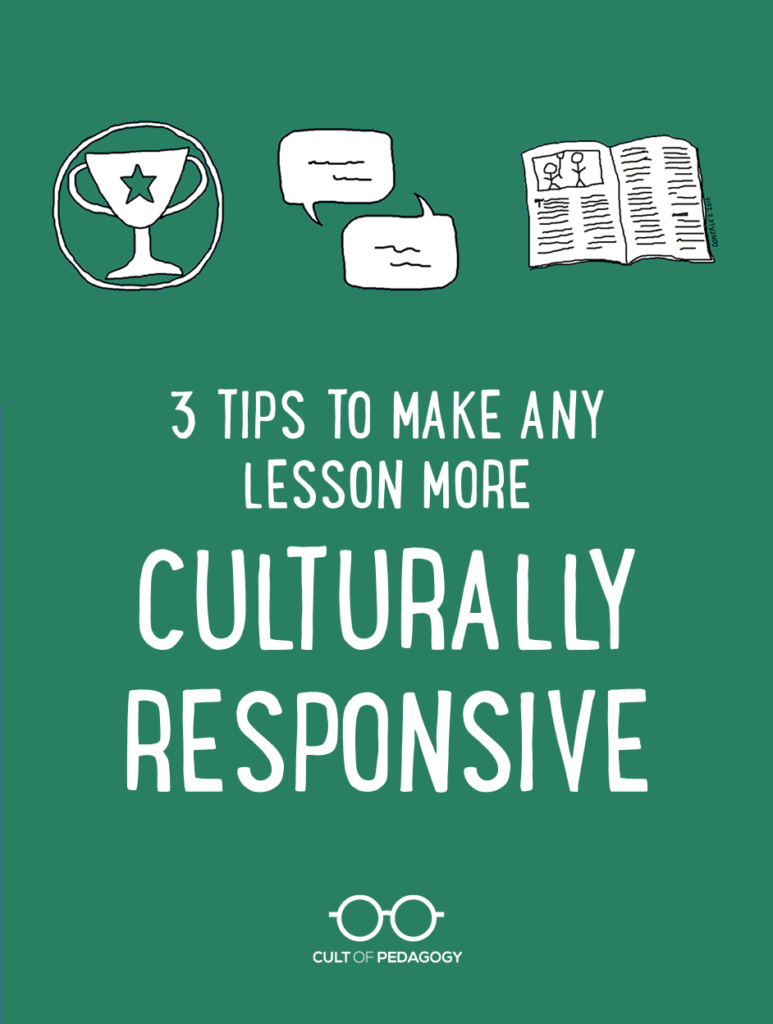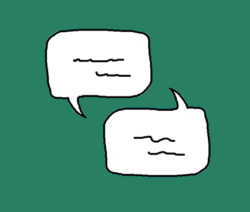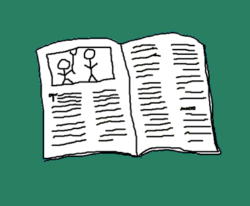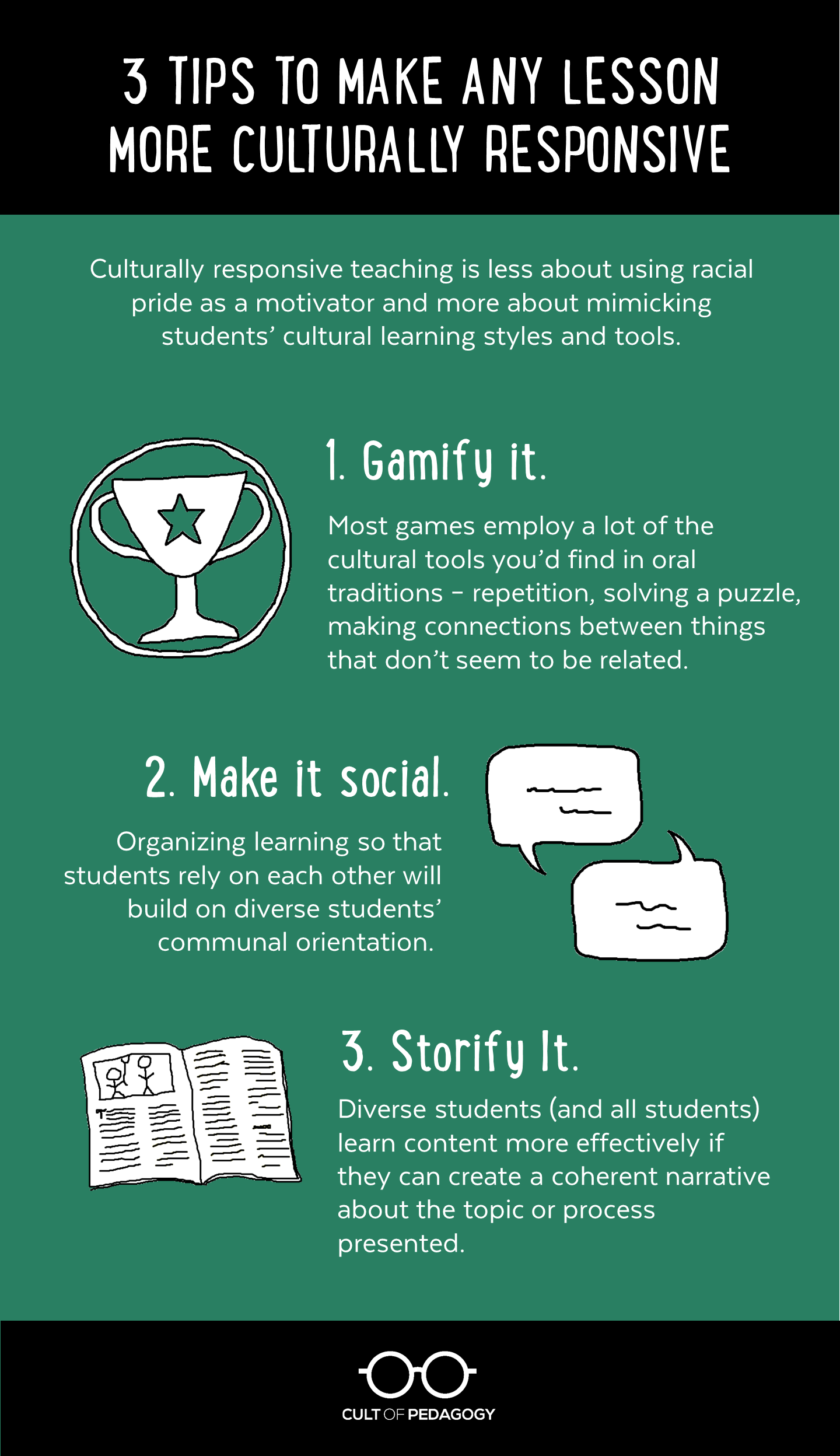3 Tips to Make Any Lesson More Culturally Responsive

Last month, I reviewed Zaretta Hammond’s fantastic book, Culturally Responsive Teaching and the Brain. Now I’m proud to have Zaretta here as a guest writer to share some specific strategies with us.
Culturally responsive teaching. Everybody is talking about it. The big question is: How do you actually make lessons culturally responsive? That comes up regularly when I am working with groups of teachers to improve outcomes for diverse students who are struggling. I remember working with a group of sixth grade teachers on improving learning for their at-risk students. These teachers were frustrated that their students, 95 percent of them students of color and English language learners, were not applying themselves to learning.
I suggested that we explore making lessons more culturally relevant in order to accelerate student learning. I remember the reaction of Janice, the science teacher. “I am not going to be rappin’ about the periodic table,” she said defiantly as she crossed her arms and sat back in her chair.
I couldn’t blame her. Google “culturally responsive teaching” and you can find a dozen videos of well-meaning teachers leading some call-and-response chant about exponents or rapping about the Boston Tea Party while students sit back and giggle. That’s because we usually talk about culturally responsive teaching only as an engagement strategy designed to motivate at-risk students to take learning seriously. Or we try to find a race-based connection to the content to make it “relevant” to minority students.
What IS culturally responsive teaching?
One of the biggest misconceptions about culturally responsive teaching is thinking you have to tie the lesson’s content to African American or Latino students’ racial background. The common belief is if you mention Africa, Mexico, or famous black and brown high achievers, it will spark students’ attention. Then they will be motivated to participate.
In reality, culturally responsive teaching is less about using racial pride as a motivator and more about mimicking students’ cultural learning styles and tools. These are the strategies their moms, dads, grandmas, and other community folks use to teach them life skills and basic concepts long before they come to school and during out-of-school time.
Culturally responsive teaching leverages the brain’s memory systems and information processing structures. Why? Many diverse students come from oral cultural traditions. This means their primary ways of knowledge transfer and meaning-making are oral and active. It’s a common cultural tradition that cuts across racial groups: African American, Latino, Southeast Asian, and Pacific Islander communities all have strong oral cultures. Each of these cultural groups uses the brain’s memory systems for turning inert information into useable knowledge. They use memory strategies to make learning sticky, like connecting what needs to be remembered to a rhythm or music (that’s why we still know the ABC song) or by reciting it in fun ways like a poem, riddle, or limerick.
I asked Janice what area of learning she wanted to help her kids improve. She said science vocabulary; they weren’t learning the weekly words and it was getting in the way of their understanding of key concepts. She was frustrated and at the end of her rope. I asked how she was teaching it. She used the typical approach: On Monday, she listed the words on the board. Students copied them down and were required to look each word up and use it in a sentence. On Wednesday, there was a vocabulary test.
I suggested that we design word study to be more culturally responsive by making it more like the students’ own cultural learning process. She was open for trying something different.
I offered her these three tips for transforming any lesson into something that looked and felt more culturally responsive to diverse students, something that would allow them to engage more and process the content effectively.
1. Gamify it.

Games are the power strategy for culturally-grounded learning because they get the brain’s attention and require active processing. Attention is the first step in learning. We cannot learn, remember, or understand what we don’t first pay attention to. Call and response is just a way to get the brain’s attention. Most games employ a lot of the cultural tools you’d find in oral traditions – repetition, solving a puzzle, making connections between things that don’t seem to be related (Ever play Taboo or Apples to Apples?).
2. Make it social.

Organizing learning so that students rely on each other will build on diverse students’ communal orientation. This communal orientation can be summed up in the African proverb, “I am because we are.” Even making learning slightly competitive in a good-natured way increases students’ level of attention and engagement. It’s why the T.V. show Survivor has been around for so many years; it’s a social-based game.
3. Storify it.

The brain is wired to remember stories and to use the story structure to make sense of the world. That’s why every culture has creation stories. In oral traditions, stories play a bigger role in teaching lessons about manners, morality, or simply what plants to eat or not eat in the wilderness because it’s the way content is remembered. Diverse students (and all students, really) learn content more effectively if they can create a coherent narrative about the topic or process presented. That’s the brain’s way of weaving it all together. (Bonus: It also offers a great way to check for understanding and correct misconceptions.)
So Janice took her weekly list of science vocabulary and created a variety of sorting and matching games for students. She built a set of simple card games based on Go Fish or Old Maid. In addition she created some team games. Each week students had different active ways to learn the vocabulary. For 10-15 minutes a couple of times during the week, students got to play these learning games rather than look up words in a dictionary. She gave them instructions for making the games at home if they wanted to.
Instead of the traditional weekly vocab test, she asked them to “storify” their understanding of key concept words like metamorphosis, using vocabulary from past weeks.
When I checked in with the group a few weeks later, she was the first one to share. She said student engagement was like night and day. Now all students were participating. She said she knew they were learning the vocabulary at a deeper level because they were actually using the new science terms during discussions and in their writing with no prompting from her.
The big A-ha’s for the group that day were that (1) Culturally responsive teaching doesn’t have to be some performance the teacher does to entertain students and (2) It doesn’t have to mention race or reference culture at all. Instead, what makes a practice culturally responsive is that it mimics students’ own cultural learning tools. They all realized that these practices are helpful for all students, not targeted at minority students.
The real trick is to use these strategies regularly as part of your instructional routine rather than doing them randomly every now and then. Consistency is the key. ♦

 Learn more about how to improve diverse students’ information processing skills and actually grow their brains in Zaretta Hammond’s book, Culturally Responsive Teaching and The Brain: Promoting Authentic Engagement and Rigor Among Culturally and Linguistically Diverse Students
Learn more about how to improve diverse students’ information processing skills and actually grow their brains in Zaretta Hammond’s book, Culturally Responsive Teaching and The Brain: Promoting Authentic Engagement and Rigor Among Culturally and Linguistically Diverse Students.
Join my mailing list and never miss another post. You’ll get weekly tips, tools, and inspiration — in quick, bite-sized packages — all geared toward making your teaching more effective and joyful. To thank you, I’ll send you a free copy of my e-booklet, 20 Ways to Cut Your Grading Time in Half. I look forward to getting to know you better!